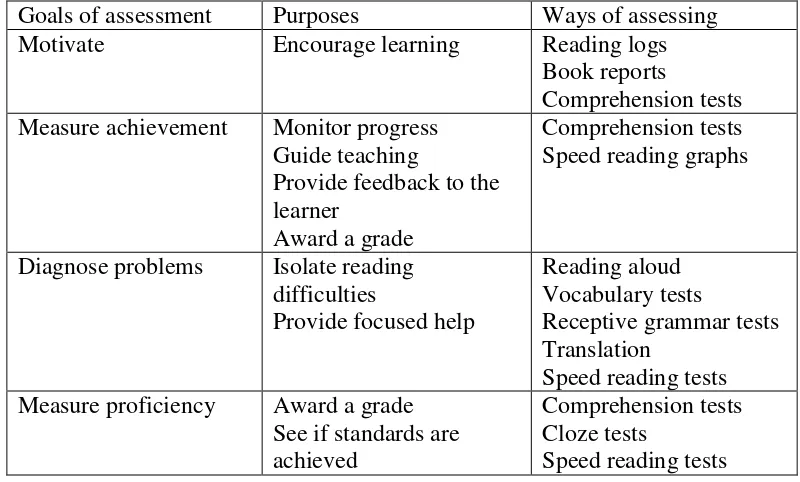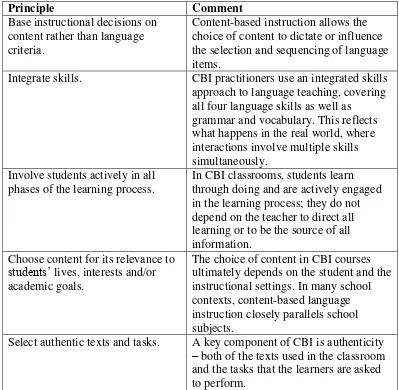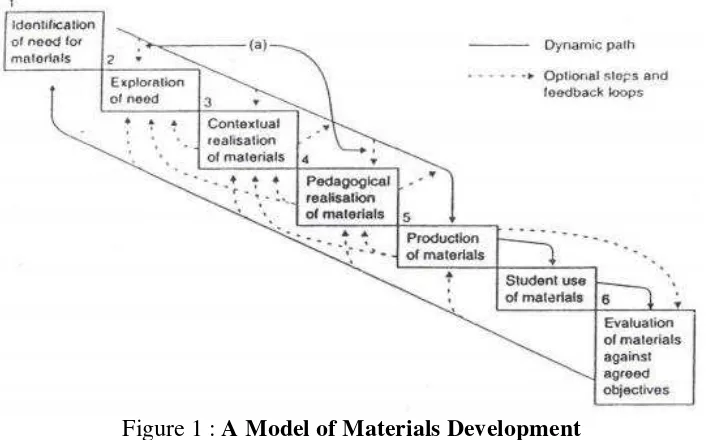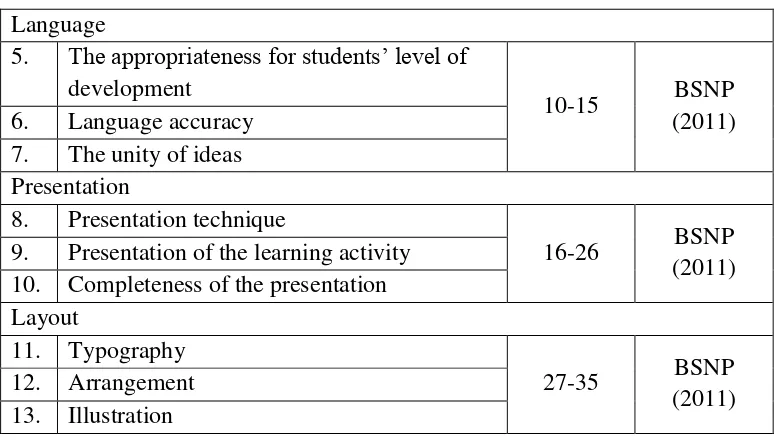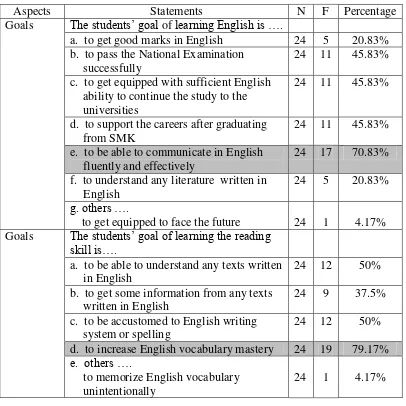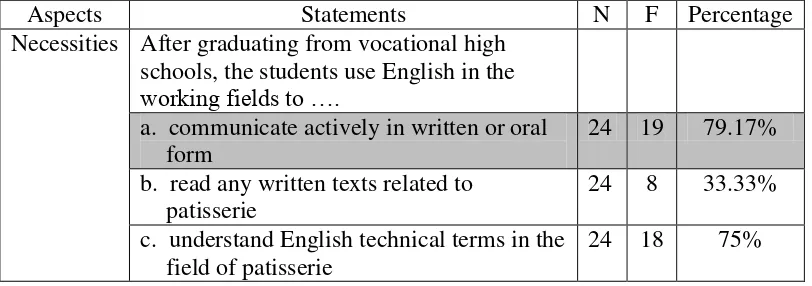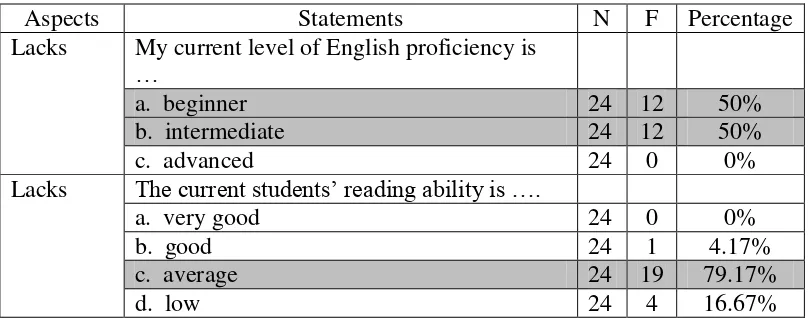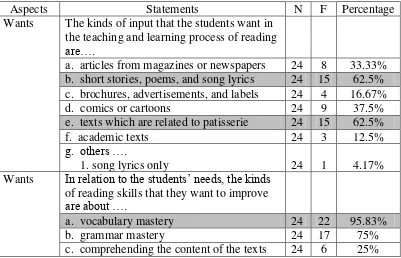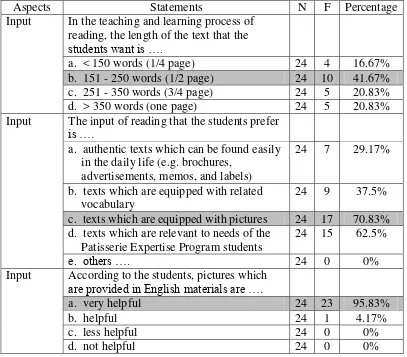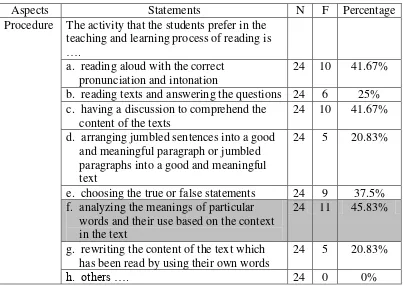DEVELOPING READING LEARNING MATERIALS FOR GRADE XI STUDENTS OF THE PATISSERIE EXPERTISE PROGRAM OF
VOCATIONAL HIGH SCHOOL
A THESIS
Presented as Partial Fulfillment of the Requirements for the Attainment of a Sarjana Pendidikan Degree in English Language Education
Laely Rachmawati 12202241017
ENGLISH EDUCATION DEPARTMENT FACULTY OF LANGUAGES AND ARTS YOGYAKARTA STATE UNIVERSITY
i
DEVELOPING READING LEARNING MATERIALS FOR GRADE XI STUDENTS OF THE PATISSERIE EXPERTISE PROGRAM OF
VOCATIONAL HIGH SCHOOL
A THESIS
Presented as Partial Fulfillment of the Requirements for the Attainment of a Sarjana Pendidikan Degree in English Language Education
Laely Rachmawati 12202241017
ENGLISH EDUCATION DEPARTMENT FACULTY OF LANGUAGES AND ARTS YOGYAKARTA STATE UNIVERSITY
iii
RATIFICATION SHEET
v
DEDICATIONS
This thesis is dedicated to:
my beloved parents, Zaeni and Siti Rahayu, my beloved brother, Zahrul Choiron, and
vi MOTTOS
So whoever does an atom’s weight of good will see it. And whoever does an atom’s weight of evil will see it.
viii
TABLE OF CONTENTS
TITLE ………... i
APPROVAL SHEET ………. ii
RATIFICATION SHEET ……….. iii
PERNYATAAN ………... iv
MOTTO ………. v
DEDICATION ………... vi
ACKNOWLEDGEMENTS ………... vii
TABLE OF CONTENTS .………. viii
LIST OF TABLES ……… xi
LIST OF FIGURES ………... xiii
ABSTRACT ………... xiv
CHAPTER I INTRODUCTION A. Background of the Study ………... 1
B. Identification of the Problems ………... 3
C. Limitation of the Problem ………... 4
D. Formulation of the Problem ………... 4
E. Objectives of the Study ………... 5
F. Specification of the Product ………... 5
G. Significances of the Study ………... 6
CHAPTER II LITERATURE REVIEW AND CONCEPTUAL FRAMEWORK A. Literature Review ………... 7
1. Reading Theory ………..………... 7
a. Definition of Reading ………... 7
b. Types of Reading ………... 9
c. Micro- and Macro-skills of Reading ……… 10
2. Teaching Reading ……….………... 12
a. Principle of Teaching Reading ………... 12
ix
c. Reading Assessment in Grade XI Vocational High Schools .. 20
d. Reading Materials for Grade XI Vocational High Schools ... . 22
3. English for Specific Purposes ……….……… 23
a. Definition of English for Specific Purposes ………... 23
b. Needs Analysis ……….……. 24
c. Materials Development in ESP ……….……….. 27
4. Content-Based Instruction ……….……….... 28
a. Definition and Principles of CBI ………...………….... 28
b. CBI Models ………..……….……….. 30
5. Materials Development ……….……….……….... 32
a. Definition of Materials Development ………... 32
b. The Model of Materials Design ……….……….. 33
c. Criteria of Good Materials ……….………. 34
6. Unit Development ………..……….……… 36
7. Task Development ……….……….……… 37
a. Definition of Tasks ………... 37
b. Task Components …..………... 38
c. Task Grading and Sequencing …..………... 40
8. Materials Evaluation …….……….………. 41
9. Relevant Studies ………….……….……… 42
B. Conceptual Framework ………... 43
CHAPTER III RESEARCH METHOD A. Type of the Research ………... 45
B. Research Setting ……….... 45
C. Research Subjects ………... 46
D. Research Procedure ……… 46
E. Data Collection Techniques and Instruments ……… 48
F. Data Analysis Techniques ……….... 51
CHAPTER IV RESEARCH FINDINGS AND DISCUSSIONS A. Research Findings ………... 52
x
2. Course Grid ……….. 66
3. The Unit Design ………... 68
4. The First Draft of the Materials ……….... 70
5. The Expert Judgment ……….... 71
B. Discussion ……….... 85
CHAPTER V CONCLUSIONS AND SUGGESTIONS A. Conclusions ………... 90
B. Suggestions ……….. 93
REFERENCES ………... 95
APPENDICES ………... 98
Appendix A. The Needs Analysis Instruments ……….. 99
Appendix B. The Needs Analysis Data ………...……….. 107
Appendix C. Course Grid ………..……… 113
Appendix D. The Description of the Tasks ………...……… 126
Appendix E. The First Draft of the Materials ………..……….…… 141
Appendix F. The Expert Judgment Questionnaire ………...…………. 209
Appendix G. The Expert Judgment Data ……….…..………...… 227
Appendix H. The Final Draft of the Materials ………….…..………...… 234
xi
LIST OF TABLES
Table 1: The Core and Basic Competences of Grade XI Vocational High
Schools ……….. 14
Table 2: Goals, Purpose and Means of Reading Assessment ………. 20
Table 3: Principles for Content-Based Instruction ………. 29
Table 4: The Organization of the Needs Analysis Questionnaire ………... 48
Table 5: The Organization of the Expert Judgment Questionnaire ………...…. 49
Table 6: Quantitative Data Conversion (Suharto, 2006) ………... 50
Table 7: The Students’ Goals of Learning English and Reading Skill ……... 52
Table 8: The Students’ Necessities ………. 53
Table 9: The Students’ Lacks……….………... 55
Table 10: The Students’ Wants………...……….... 56
Table 11: Input for Learning Reading ……….... 58
Table 12: Procedures for Learning Reading ………..….... 59
Table 13: Teacher’s Roles in Learning Reading ……….... 62
Table 14: Learner’s Roles in Learning Reading……….…….... 63
Table 15: Setting of the Reading Learning Process ………..………….…….... 64
Table 16: The Appropriateness of the Content of Unit 1 ……….……. 71
Table 17: The Appropriateness of the Language of Unit 1 ………... 72
Table 18: The Appropriateness of the Presentation of Unit 1 ………….…... 73
Table 19: The Appropriateness of the Layout of Unit 1 ……….……... 73
Table 20: The Revisions of Unit 1 ……….…….... 74
Table 21: The Appropriateness of the Content of Unit 2 ……….……. 76
Table 22: The Appropriateness of the Language of Unit 2 ………... 77
Table 23: The Appropriateness of the Presentation of Unit 2 ………….…... 77
Table 24: The Appropriateness of the Layout of Unit 2 ……….……... 78
Table 25: The Revisions of Unit 2 ……….…….... 79
Table 26: The Appropriateness of the Content of Unit 3 ……….……. 80
Table 27: The Appropriateness of the Language of Unit 3 ………... 81
xii
xiii
LIST OF FIGURES
xiv
DEVELOPING READING LEARNING MATERIALS FOR GRADE XI STUDENTS OF THE PATISSERIE EXPERTISE PROGRAM OF
VOCATIONAL HIGH SCHOOL By:
Laely Rachmawati 12202241017
ABSTRACT
The objectives of this research were to describe the target and learning needs of Grade XI students of the Patisserie Expertise Program of vocational high schools in terms of the reading teaching and learning context and to develop the appropriate reading learning materials for Grade XI students of the Patisserie Expertise Program of vocational high schools.
This was a Research and Development (R&D) study. The subjects of this research were Grade XI students of the Patisserie Expertise Program of SMKN 6 Yoyakarta. The research procedure was adapted from the model of materials development proposed by Jolly and Bolitho in Tomlinson (1998). To collect the data of the research, two types of questionnaires were used as the instruments. The first was the needs analysis questionnaire which was made to obtain the data about the students’ target and learning needs and the second was the expert judgment questionnaire which was made to obtain the data about the appropriateness of the materials developed. The data from the needs analysis and the expert judgment were analyzed quantitatively through descriptive statistics.
1 CHAPTER I INTRODUCTION
A. Background of the Study
Vocational high schools are secondary education which aims to prepare the students to be ready to work in particular fields after they graduate. Thus, the focus of the learning process is on developing the students’ skill and knowledge which is in line with their study programs. Though the students’ hard skills will be
highly needed in their future work, having a good language skill is also important since language covers almost all aspects in people’s life including professional
works. In relation to this, foreign language mastery, especially English as an international language, is important to learn. There are many jobs which demand a
good English competency. Thus, English is one of the compulsory subjects to be taught in a vocational high school.
Regarding the goal of the English teaching and learning process in vocational high schools, students are expected to have a good communicative skill and literacy. Nowadays, many jobs need English both in spoken and written
forms. For those who work with foreign people, they need to have a good English proficiency in order to be able to communicate effectively. Then, a good literacy
The Patisserie Expertise Program is one of the majors in vocational high schools which prepare the students to be professional pastry chefs. To attain this,
they should be well-informed about current development of their field. Since one of their concerns is about continental pastry, there must be many references
written in English. In this situation, they need to have a good English competency to understand the information. In addition, after they graduate, they might continue their study or apply for a job overseas. If so, they also need English to
succeed.
To achieve a good English competency, appropriate materials are needed
in the teaching and learning process. Materials play important roles such as initiating learning and providing input for students. Dealing with input, relevant reading materials are important since they provide much exposure to vocabulary,
technical terms, and information related to a certain discipline. Furthermore, the appropriateness is one of the important things to be considered. Those which are
involved should be related to a particular students’ field so that the learning process will be meaningful.
Based on the preliminary observation in SMKN 6 Yogyakarta, especially
in the Patisserie Expertise Program, it is found that the available materials, especially for reading, do not completely meet the students’ needs since the
content is too general for their specific field of study. On the other hand, the students should have relevant materials to facilitate their English learning processes. For this reason, reading materials which are suitable for this specific
B. Identification of the Problem
Based on the background of the study, there are three problems which can
be identified related to this study. The problems are about the unsuitable materials, the unavailability of the materials, and the teacher factor.
Regarding the first problem, since the implementation of the new curriculum, the only source of learning the students have is the English textbook provided by the government based on Curriculum 2013. These books are actually
allocated both for vocational and senior high schools. Moreover, the contents being covered are general English. By considering the students’ specific fields to
study, the provided materials do not really fulfill their needs.
On the other hand, the materials which are relevant to the needs of the students are very difficult to find. Those kinds of materials are not available in the
market and very limited on the internet. Even if there are some, they should also meet the requirement of Curriculum 2013. This makes it harder to find such good
ones.
Probably, the teachers can develop materials that suit the students’ needs
by themselves as one of the solutions for this problem. However, they cannot do
that for their lack of time and knowledge. Because developing materials is not an easy and simple process, the teachers tend to simply use what are available as the
C. Limitation of the Problems
Regarding the problems which have been identified, appropriate materials are needed to develop to support the students’ learning process. For this reason,
this study focuses on developing English learning materials for the students of the
Patisserie Expertise Program. Due to time constraints, the materials which are developed are specified for the aspect of reading of Grade XI students of the Patisserie Expertise Program.
D. Formulation of the Problems
By considering the limitation of the problems, the research problems can be formulated as follows:
1. What are the target needs of Grade XI students of the Patisserie Expertise
Program of vocational high schools in terms of the reading teaching and learning context?
2. What are the learning needs of Grade XI students of the Patisserie Expertise Program of vocational high schools in terms of the reading teaching and learning context?
E. Objectives of the Study
The objectives of this study are:
1. To describe the target needs of Grade XI students of the Patisserie Expertise Program of vocational high schools in terms of the reading teaching and
learning context.
2. To describe the learning needs of Grade XI students of the Patisserie Expertise Program of vocational high schools in terms of the reading teaching
and learning context.
3. To develop the appropriate reading learning materials for Grade XI students
of the Patisserie Expertise Program of vocational high schools.
F. Specification of the Product
The product of this research is a textbook for the classroom teaching and learning process of reading for Grade XI students of the Patisserie Expertise
Program. It was developed based on the core and basic competences for reading of Curriculum 2013. It consists of three units whose topics are related to the field of patisserie. These units are comprised of 17 to 19 tasks and have four main
parts, namely introduction, main reading activities, reinforcement, and intermezzo. Each unit covers different text types to explore. They are explanation
G. Significances of the Study
This study is expected to give valuable contributions to the following
parties:
1. Theoretically, the findings of this research can be used as the reference for
other researchers in developing reading materials for other programs. 2. Practically, the results of the research will be useful for:
a. Teachers of the Patisserie Expertise Program
The result of this research will help English teachers in providing relevant reading materials in the teaching and learning process.
b. Grade XI students of the Patisserie Expertise Program
7 CHAPTER II
LITERATURE REVIEW AND CONCEPTUAL FRAMEWORK
This chapter deals with the theoretical review and the conceptual
framework of the research. In the first discussion, some relevant theories will be examined. Then, the conceptual framework will follow in which it relates the theories presented with the the flow of the research.
A. Literature Review 1. Reading Theory a. Definition of Reading
In language learning context, reading is one of the receptive skills which is closely related to written texts as the input. Though it is a receptive skill, reading is not a passive process. Reading is an active process that requires the readers to
have a great deal of practice and skill (Moreillon, 2007). This active process includes constructing and creating meaning from the text. As Duffy (2009) states, reading is more about creating understandings than receiving understandings.
From the other perspectives, reading is not just a visual activity since both visual information and nonvisual information are essential for reading (Smith,
2008). When someone engages in a process of reading, there will be something happening between text, brain and eye. According to Johnson (2008), reading is the practice of using text or written information to create meaning. He also states
eyes combines with the nonvisual information contained in our head to create meaning.
For the next definition, Grabe and Stoller in Celce-Murcia (2001) explain that a process of reading requires the reader to draw information from a text and
combine it with information and expectations that he or she already has. In line with this statement, Smith (2008) argues that, referring to a piece of writing, reading is interpreting or making sense of it to everything the reader has already
known. From these two definitions, the nonvisual information mentioned in the previous paragraph can be seen as the reader’s background knowledge. In short,
reading can be defined as a process of constructing meaning from written input by relating them with our prior knowledge.
To this point, it can be concluded that reading is not a simple activity. Both
mental and cognitive processes are involved in reading. One of the mental processes involved in reading is decoding. This process includes turning the
written form of a word into a spoken form which the reader is familiar with (Nation, 2009). In addition, Flynn and Stainthorp (2006) say that decoding is a separate cognitive process which involves translating the visual stimuli into
language. They also simply state that reading is an ability to decode the print and to comprehend the language. In sum, the process of reading begins with decoding
b. Types of Reading Skills
In reading different kinds of texts, the readers tend to go through different processes. The processes in reading a novel for example, will not be the same as those in reading a recipe since what the readers are reading for are different.
Based on the purposes of reading, there are six different types of reading skills (Harmer, 2001). These skills are identifying the topic, predicting and guessing, reading for general understanding, reading for specific information, reading for
detailed information, and interpreting text.
The first skill which is identifying topic is used when the readers want to
get the idea of what they read. In predicting and guessing, the readers can predict the content without reading the whole text. Next, reading for general understanding is usually known as skimming. It means reading quickly to get an
idea without worrying about the details. Meanwhile, reading for specific information or scanning is used to find specific detail information. Then, to
understand everything of the text in detail, the skill which is used is reading for detailed information. For the last type of the reading skill, interpreting text is needed in order to see beyond the literal meaning and understand the implied
meaning of words.
On the other hand, types of reading can be identified based on what
students can perform in a classroom. Brown (2001) points out that there are two types of classroom reading performance which are oral and silent reading. Though the first one is not a very authentic language activity, teachers occasionally ask
participation in a certain short segment of a reading passage. Meanwhile, silent reading can be subcategorized into intensive and extensive reading.
Intensive reading draws students’ attention to language features and
content details of a passage. Comprehension of the text may be the goal of this
kind of reading (Nation, 2009). In contrast to this, extensive reading is carried out to achieve a general or global understanding of longer texts (Brown, 2001). The texts which are chosen are usually interesting and engaging for students because
extensive reading is often pleasure reading. Extensive reading provides the conditions for fluency development if the texts that learners read are very easy
ones with almost no unknown items, and it fits into the meaning-focused input if the texts contain only a few unknown vocabulary and grammar items (Nation, 2009).
c. Micro- and Macro-skills of Reading
In the teaching and learning process of reading, teachers should understand the micro- and macro-skills of reading in order to gain the objectives that are expected. These micro- and macro-skills are what students need to do to become
efficient readers. There are respectively seven micro- and macro-skills of reading provided by Brown (2004).
Before the discussion of the macro-skills, it will be explained first the seven micro-skills of reading. For the very beginning, students need to be able to recognize the writing system of English which are different from the other
lengths in short-term memory. Third, according to the purpose, they are able to make a sense of writing at a certain rate efficiently. Fourth, students can recognize
the basic forms of words and know the different meaning of words with the different order. Fifth, students should recognize grammatical word classes or parts
of speech and how they change in a certain pattern with a certain rule. Sixth, they understand that a particular meaning can be expressed in different grammatical forms. Seventh, students are expected to be able to recognize cohesive devices in
written texts and their functions.
For the macro-skills, the first thing the students need to develop is
recognizing the importance of the order of information in written texts for interpretation. Secondly, knowing the communicative function of written texts according to form and purpose is important for students. Then, by using their
background knowledge, students should have an ability to infer the context which is stated implicitly. Next, from described events or ideas, they need to be able to
infer the connections between those events, give the main ideas, the supporting ideas, new information, given information, conclusions, and other examples of the related events. After that, the fifth skill students should have is the ability to
distinguish between the meaning of the text based on what is actually written and the meaning which is not stated directly. For the sixth skill, they are expected to
From what are mentioned above, it can be inferred that the micro-skills tend to focus on chunks of language. On the other hand, the macro-skills cover
broader aspects of language or beyond what is written on the texts. In the context of the reading process, the micro- and macro-skills of reading are closely related
to microprocesses and macroprocessess of reading. Kintsch and Yarbrough in Alderson (2000) relate the former to local understanding which is in the level of words and phrases and the later to global understanding. In short, by considering
the micro- and macro-skills of reading, teachers can decide how the sequence, activities, materials, and assessment of students’ reading will be.
2. Teaching Reading
a. Principles of Teaching Reading
Teaching reading is not simply giving students written texts and asking them to read followed by some questions. There are some principles that should
be taken into consideration. According to Harmer (2001), there are six principles behind the teaching of reading.
1) Students should be encouraged to read as often and as much as possible.
It is important to encourage students to read both extensively and intensively because the more they read, the better. The teacher might discuss the benefit
2) Students need to be engaged with what they are reading.
In order to succeed in reading, they should be actively interested in what they
are doing. Thus, the teacher should ensure that students can get much pleasure from reading when they are dealing with it.
3) Students should be encouraged to respond to the content of a text, not just to the language.
It is important for students to not only understand the language use but also
knowing the meaning, responding to the message, and expressing their feeling about the content of the texts.
4) Prediction is a major factor in reading.
Teachers should provide some hints for students so that they will be able to predict the idea of the text. Besides, those can also engage students’ attention.
5) Match the task to the topic
Teachers have to choose the appropriate tasks for a certain kind of texts
because it will determine whether the reading activity is interesting or not. The appropriateness of the tasks can be seen based on what kinds of activities students are going to do and how challenging those activities will be.
6) Good teachers exploit reading text to the full.
Teachers should be able to integrate the reading text into interesting class
sequences. Some further tasks can be made by elaborating the texts.
list of principles which covers meaning-focused input, meaning-focused output, language-focused learning, and fluency development.
1) Meaning-focused input
A reading learning process should covers some purposes such as reading to
search for information, reading to learn, reading for fun, and reading to write. Then, the reading materials need to be appropriate to students’ language proficiency levels. In this first point, reading should also be used as a way of
developing language proficiency. 2) Meaning-focused output
In this case, reading activities must be integrated to the other language skills which are listening, speaking, and writing.
3) Language-focused learning
Students have to be trained to practice and integrate a range of reading strategies, develop the skills and knowledge for effective reading, and be
familiar with the kinds of text structures. 4) Fluency development
Developing fluency in reading is very important for students. Thus, there should be speed reading practices. In developing students’ fluency, teachers
should make students enjoy reading and feel motivated to read. So, teachers
b. Teaching Reading in Grade XI Vocational High Schools
As mentioned in the Act of National Education System No. 20/2003, a curriculum is a set of plans which are used as the guideline in the teaching and learning process to achieve some specific purposes of education. Since the
2013/2014 academic year, Curriculum 2013 is applied in Indonesia. Not all schools, including vocational high schools, have implemented it yet though. Some of them have changed the curriculum while the others still use School-based
Curriculum (KTSP).
Referring to the Act of Ministry of Education and Culture No. 22/2016
about standard of the process in primary and secondary education, the objectives of learning process in Curriculum 2013 cover three aspects which are attitude, knowledge and skill. For the English subject, reading belongs to the skill
competence. Thus, it should be developed further in the teaching and learning process.
In Curriculum 2013 for vocational high schools, English core competences are formulated in four aspects in which each aspect is explained further in basic competences. The following table shows the example of reading competence for
Grade XI according to the Act of Ministry of Education and Culture No. 22/2016. Table 1: The Core and Basic Competences of Grade XI Vocational High Schools
Core Competence Basic Competence
3. Understanding, applying, and analyzing factual, conceptual, procedural, and metacognitive knowledge based on their curiosity about science, technology, art, culture, and
humanity with the concept of humanism, nationalism, and civilization in relation to the causes of phenomena and applying procedural
knowledge in a specific field based on their talent and interest to solve problem.
contexts.
3.4 Differentiating the social functions, structure of the texts, and language elements of some spoken and written analytical exposition texts by giving and asking for information related to the actual issues and based on the contexts.
3.8 Differentiating the social functions, structure of the texts, and language elements of some spoken and written explanation texts related to the natural or social phenomena which are
covered in the other subjects in Grade XI based on the contexts.
From the core and basic competences, then teachers will know what they are going to teach. Moreover, they are expected to be able to decide what kind of
activity and how the assessment will be. In addition, they should choose the appropriate reading materials in order to achieve the goal of teaching and learning process.
It has been stated in the previous discussion that a curriculum contains a guideline which is used in the teaching and learning process. In Curriculum 2013,
this guideline is presented in the Act of Ministry of Education and Culture No.103/2014 about teaching process in primary and secondary education. Referring to this, there are five steps of the teaching and learning process which is
known as the scientific approach. This process is started from observing, questioning, collecting, associating, and then communicating. Actually, these five
The steps in scientific approach are quite different from those which are proposed by Stoller and Grabe in Celce-Murcia (2001). Regarding the reading
steps, they suggest a general framework based on pre-, during-, and postreading instruction. Prereading instruction helps students access background information
and gives specific information which are needed for successful comprehension. Then, during-reading instruction guides students to understand and making sense of relationship among ideas in the text. Furthermore, students will be able to read
purposefully and strategically. Meanwhile, postreading instruction ensure students that the major ideas and supporting information are well understood.
Furthermore, Stoller and Grabe in Celce-Murcia (2001) gives some activities commonly used in each step of reading. In prereading activities, teachers can ask students to preview the text by examining the title, subheadings,
illustration, or captions to determine the general topic of the reading. Besides, students may skim the text to decide the main ideas, formulate some questions,
explore key vocabulary, or review information from previously read texts and find the relation to the text which is going to be read. Next, in during-reading activities, students usually outline key ideas, examine emotions of key characters,
clarify some difficulties, look for answers to questions posed during prereading activity, and writing down predictions of what will come next. After doing some
By considering the Act of Ministry of Education and Culture about the teaching process, it is not a must for teachers to completely follow the exact steps
in the scientific approach. Some activities which have mentioned above or other theories of language learning might be adapted in order to make the reading
learning process run better.
Again, the steps in the scientific approach are generally used for all school subjects. Since the language teaching and learning has its own characteristic, there
will be some different activities in each step. It goes so in the context of the reading teaching and learning process. The five steps of the scientific approach are
then presented below. 1) Observing
In this first step, students are allowed to make observations through
reading, listening, or watching. In the context of reading, students read a piece of written text and make a list of some points they have not known yet
and want to know further.
This stage is typically similar to the first step of a three-phase sequence of a lesson that is the P-P-P cycle (Presentation, Practice, Production). According to Richards (2006), the Presentation stage presents the new grammar structure by means of a conversation or short text and followed by checking students’ comprehension of it. Through presenting a short text,
2) Questioning
In this stage, students propose some questions and have a discussion to
clarify them. By considering some activities previously explained by Stoller and Grabe in Celce-Murcia (2001), this second stage can be included in the
prereading activity in which students formulate questions for which students want answers.
3) Collecting
In collecting step, students collect more information and explore other sources that are relevant to their questions. This collecting step is close to
what is described in information-gap activities where the students practice and use the language for their own sake in order to obtain information (Richards, 2006).
4) Associating
Moving to the next step, students analyze the data and information they
got and relate them one another until they eventually arrive at the answers or conclusions for the questions. From what has been mentioned by Stoller and Grabe in Celce-Murcia (2001), this activity is similar to those in
during-reading activity such as seeking clarification and looking for answers to questions posed during prereading activity.
5) Communicating
Richards (2006), in the production step, students practice using the new structure in different contexts in order to develop fluency. This is in line with
what students do in communicating step because in communicating their conclusion, students are expected to be able to use the new structure with the
new pattern based on their findings.
c. Reading Assessment in Grade XI of Vocational High Schools
In language teaching, assessment is an ongoing process that covers a much wider domain (Brown, 2004). As the consequence, there are some purposes of assessment instead of to know the level of students’ performance in English only.
It is the same as true with the assessment process in reading. Caldwell (2008) states that the basic purposes of reading assessment are identifying good reader
behaviors, identifying area of weakness, determining student reading level, and documenting student progress. From the other point of view, Nation (2009) gives
several reasons for assessing reading and the skills and knowledge that are involved in reading. These include assessing to encourage learning, assessing to monitor progress and provide feedback, assessing to diagnose problems, an
assessing to measure proficiency. By considering these, teachers can decide the technique of assessment they that may be used for a variety of goals.
Before going further to discuss about the technique of assessing reading, it is important to understand that good assessment needs to be reliable, valid and practical (Nation, 2009). In addition, Caldwell (2008) explains that a reliable test
under similar situations. Then, regarding the validity, assessments should reflect the skills, behaviors, or content to be measured. Meanwhile, related to the
practicality of assessments, it can be helped by giving as clear as possible explanations about how learners will answer the test and how it will be marked
(Nation, 2009).
As has been mentioned before, the ways or techniques can be used in reading assessment might be chosen based on the goals have been determined.
[image:36.595.117.517.389.630.2]Referring to Nation (2009: 76), goals, purposes, and means of reading assessment are presented in the table below.
Table 2: Goals, Purpose and Means of Reading Assessment
Goals of assessment Purposes Ways of assessing Motivate Encourage learning Reading logs
Book reports
Comprehension tests Measure achievement Monitor progress
Guide teaching
Provide feedback to the learner
Award a grade
Comprehension tests Speed reading graphs
Diagnose problems Isolate reading difficulties
Provide focused help
Reading aloud Vocabulary tests
Receptive grammar tests Translation
Speed reading tests Measure proficiency Award a grade
See if standards are achieved
Comprehension tests Cloze tests
Speed reading tests
On the other hand, based on the Act of Ministry of Education and Culture No. 104/2014, reading, which includes in skill competence, can be assessed
students. Then, project is a sort of activities starting from planning, realization, and arranging oral or written report. While assessing product is done by asking the
students to make a certain thing through some processes. In this case, the products might be those which require students’ reading ability in completing them. Next,
portfolio basically is a kind of assessment in which the students have to collect their works individually. After a certain period, eventually those will be assessed by the teacher. Lastly, written activity such as making a short essay or letter can be also used to assess students’ skill competence.
For the materials will be developed in this research, the students’ reading
skill will be assessed mainly through some practices. Furthermore, to measure students’ achievement and reading proficiency, comprehension test are going to
be arranged. Meanwhile, some vocabulary and receptive grammar tests will also
be provided as well in order to diagnose students’ problems or difficulties and monitor their progress.
d. Reading Materials for Grade XI of Vocational High Schools
Materials are an important component in language teaching and learning. In teaching reading especially, the choice of appropriate primary text and textbooks, supporting resources and classroom library materials will increase students’ motivations to read and their engagement with text (Stoller and Grabe in
Celce-Murcia, 2001). In addition, Serravallo (2010) explains that reading instruction should match the individual reader, train students to be independent
consider the importance of time spent, volume, and variety of reading, and follow predictable structures and routines.
Referring to teaching English in vocational high schools, it is closely related to the approach of English for Specific Purposes (ESP) since the students
are prepared to be ready to cope with their specific fields. Therefore, if the criteria above have been fulfilled, reading materials should also provide exposure to the specialized genres and registers of ESP (Richards, 2001)
On the contrary, the English course book provided especially for Grade XI students of vocational high schools does not completely fulfill the criteria for
good reading materials. The book published by Ministry of Education and Culture for Curriculum 2013 only covers general English and it is used for both senior high schools and vocational high schools as well. Thus, this research is aimed to
develop the appropriate materials for Grade XI students of vocational high schools especially for the Patisserie Expertise Program. The materials will be based on the
core and basic competences for Grade XI of vocational high schools in Curriculum 2013.
3. English for Specific Purposes
a. Definition of English for Specific Purposes
As technology and commerce develop rapidly in a globalization era, there is a demand for an international language. Then, since English has taken its role as the international language, many people learn English for many different
certain needs and demands. Thus, there is an approach to language learning which is called English for Specific Purposes (ESP).
According to Hutchinson and Waters (1991), instead of a language product, English for Specific Purposes (ESP) is an approach to language learning,
which is based on learner need. Furthermore, the approach is used to make a decision about the content and method which will be used based on the learners’
purposes in learning. Supporting this view, Richards (2001) also states that ESP concerns to make language courses more relevant to learners’ needs. So, basically,
ESP is developed based on why people learn English and what for.
From the other point of view, ESP is a movement based on the idea that all language teaching should be tailored to the specific language use and learning needs of certain groups of learners (Johns and Machado in Celce-Murcia, 2001).
In addition, Basturkmen (2008) states that typically, the purpose of ESP is to help language learners to deal successfully with the features of language or to develop
the competencies needed to function in a discipline, profession, or workplace. Thus, the language features in ESP teaching will be based on the target needs which then can be identified by doing needs analysis.
b. Needs Analysis
In terms of linguistic deficiency, needs are often described as the difference between what learners can presently do in a language and what they should be able to do (Richards, 2001). While in the language-centred approach,
target situation (Hutchinson and Waters, 1991). The target situation itself refers to those learners should complete in their future jobs. So, in ESP context, needs are
language features that learners should have in order to be able to carry out their tasks.
In relation to this, Richards (2001) states further that in ESP, learner’s
needs are often described in terms of performance or what the learner will be able to do with the language at the end of a course of study. These should be identified
before determining the content of any course because different types of learners will have different language needs.
An attempt which is usually made to discover learners’ true needs is
known as needs analysis (Hutchinson and Waters, 1991). There are some procedures suggested for conducting needs analysis. These are questionnaires,
surveys, and interviews.
According to Richards (2001), there are some purposes of needs analysis
in language teaching, for example, finding out what language skills a learner needs in order to perform a particular role, helping determine if an existing course adequately addressed the needs of potential students, and determining which
students from a group are most in need of training in particular language skills. Besides, needs analysis is aimed to identify a change of direction that people in a
In needs analysis, basic information that should be gathered are target needs and learning needs. Then, the information about the target situations must
be taken into consideration also. Hutchinson and Waters (1991) explain that target needs refer to what the learner needs to do in the target situation, and learning
needs are what the learner needs to do in order to learn. Meanwhile, target situations are those that are related to what occasion in which the learner performs the language.
In relation to the target needs, there are three important things to be considered. They are necessities, lacks, and wants. Necessities can be defined as
what learners have to know so that they can communicate effectively in the target situation. This type of need is determined by the demand of the target situation (Hutchinson and Waters, 1991). Then, lacks are identified by find out what
learners already know and do not know about the language used in the target situations. In other words, lacks refer to the gap between the existing proficiency
of the learners and the target proficiency. For the last term, wants are what learners expect during their language learning processes such as any kinds of learning activities the learners expect.
Beside the target needs, learning needs and target situation analysis are also important to be taken into account. Dealing with learning needs, some points which need to be analyzed are the learners’ learning background, the learners’
interests and socio-cultural background, and the resources are available. The information about learning needs will be used to determine how the learning
concerned with language use (Hutchinson and Waters, 1991). The information can be about the content of the area, how, when, and where the language will be used.
In sum, information for the needs analysis can be gathered from the learners and those who know the target situation well. Then, the information can
be used as the consideration to determine what kind of methods and materials which are appropriate for the learners.
c. Materials Development in ESP
In the language teaching and learning process, materials play an important
role such as providing input for students. Input refers to language sources that are used to initiate the language learning process (Richards and Renandya, 2002). Initiating learning might be one of important steps which will decide whether the
process will run well or not. Consequently, the suitability should be the priority in choosing learning materials.
In ESP context, teachers need to provide teaching materials that fit the specific subject area of particular learners (Hutchinson and Waters, 1991). To produce relevant ESP materials, they must be aware of what is involved. In
relation to this, Hutchinson and Waters (1991) have proposed some principles as the guidance in writing ESP materials.
2) Materials should provide a clear and coherent unit structure that will guide both teachers and learners through various activities to maximize the chances
of learning. Therefore, materials should not be monotonous. Some illustrations might be needed to make them more interesting.
3) Materials follow a view of the nature of language and learning. People learn when their thinking capacities are engaged. So, the materials should provide exercises which require active thought. Then, make sure that it also gives
frequent reinforcement to enhance the learning process.
4) Materials reflect the nature of the learning task. In relation to this principle,
the complexity of the materials should be taken into account.
5) Materials can be very useful to broaden the basis of teacher training by introducing them to new techniques.
6) Materials provide models of correct and appropriate language use.
Once again, materials in ESP should fit the learners’ subject area.
Therefore, deciding the approach which will be used in developing materials is one of the important points to be considered. In this case, content-based instruction (CBI) is regarded as the most appropriate one since the content might be generated from an analysis of learners’ needs (Nunan, 2004).
4. Content-Based Instruction a. Definition and Principles of CBI
In defining content-based instruction (CBI), there are two experts who
teaching of content or information in the language being learned without separating the language itself from the content being taught. In addition to this
statement, Larsen-Freeman (2000) explains that CBI approach integrates the language with the content of academic subject matter in the learning process.
Those two statements imply that to achieve the communicative purposes, CBI provides the appropriate language learning process in terms of both content and language. Accordingly, this approach is in keeping with the English for Specific
Purposes tradition, where the vocational needs of the learner are identified and used as the basis for materials development (Snow in Celce-Murcia, 2001)
In materials development, the point of departure of CBI approach is derived from experiential content which may come from other subjects on the school curriculum rather than linguistic criteria (Nunan, 2004). In line with this
statement, Richards (2006) argues that decisions about content in CBI approach are made first, and other kinds of decisions concerning grammar, skills, functions,
etc., are made later. Furthermore, Nunan (2004) states that one of the benefits of this approach is, in an integrated way, it can help school learners master other aspects of school learning in addition to language. In sum, CBI is the approach
which focuses on involving content of the relevant subject matter into language learning materials or language input.
Table 3: Principles for Content-Based Instruction
Principle Comment
Base instructional decisions on content rather than language criteria.
Content-based instruction allows the choice of content to dictate or influence the selection and sequencing of language items.
Integrate skills. CBI practitioners use an integrated skills approach to language teaching, covering all four language skills as well as
grammar and vocabulary. This reflects what happens in the real world, where interactions involve multiple skills simultaneously.
Involve students actively in all phases of the learning process.
In CBI classrooms, students learn through doing and are actively engaged in the learning process; they do not depend on the teacher to direct all learning or to be the source of all information.
Choose content for its relevance to students’ lives, interests and/or academic goals.
The choice of content in CBI courses ultimately depends on the student and the instructional settings. In many school contexts, content-based language instruction closely parallels school subjects.
Select authentic texts and tasks. A key component of CBI is authenticity – both of the texts used in the classroom and the tasks that the learners are asked to perform.
b. CBI Models
Models of content-based instruction can be distinguished from each other by setting, instructional level, and the degree of emphasis on language and content
which underlies a particular program (Snow in Celce-Murcia, 2001). Based on the setting, some models are specifically implemented in the foreign language setting
implemented at the elementary school, while others have typically been implemented at the secondary or postsecondary levels. Meanwhile, for the last
point, there are content-driven at one end and language-driven at the other end. Furthermore, Snow in Celce-Murcia (2001) describes five models of
content-based instruction. The explanation for each model is presented below. 1) Immersion Education
In this model, foreign language is used for instruction. This model is then
divided into total and partial immersion.
2) Content-Enriched Foreign Language in the Elementary School
For this model, “travelling” language teachers met with elementary school
children for about 20 to 30 minutes, several times per week, for instruction in the foreign language.
3) Sheltered Model
This model separates second/foreign language students from native speakers
of the target language or the purpose of content instruction. 4) Adjunct Model
In this model, students are concurrently enrolled in a language class and a
content course. 5) Theme-Based Model
This is a type of content-based instruction in which selected topics or themes provide the content from which teachers extract language learning activities.
Regarding the models above, the first two are well-implemented in
postsecondary second language settings. Then, those five models are mentioned from the most content-driven one to the most language-driven.
From those five models of CBI, the theme-based model is considered to be the most appropriate one to be implemented in the materials which are developed.
As has been stated before, this model is well-implemented in secondary language settings including vocational high schools. Supporting this statement, Richards and Rodgers (2002) argue that the theme-based model is commonly used at the
secondary level and focuses on learning strategies, tasks, and skills that are needed in subject areas.
5. Materials Development
a. Definition of Materials Development
Tomlinson (1998) defines materials development as anything which is done by writers, teachers or learners in an attempt to provide sources of language
input and to exploit those sources in order to make the items pass from input to intake. Furthermore, materials development has been defined as the process of planning and creating units and lessons which is done by a teacher to complete the
goals of the course (Graves, 2000). From these two definitions, it can be inferred that materials development is an attempt to provide sources of learning in order to
achieve the goals of the teaching and learning process.
Regarding the goal of materials development, Richards (2001) states that creating materials can serve as resources for effective learning since preparing
teaching a lesson. For a teacher, the process of materials development includes creating, choosing or adapting, and organizing materials and activities so that the
students can achieve the objectives and eventually reach the goals of the course (Graves, 2000). Then, to develop materials, teachers or developers need to follow
some certain steps of designing materials. A particular model of material design will be explained in the following part.
b. The Model of Materials Design
In the process of materials writing, various steps are involved. Those steps
[image:48.595.157.513.425.645.2]can be seen from the following illustration proposed by Jolly and Bolitho in Tomlinson (1998: 98).
Figure 1 : A Model of Materials Development
In the first step of materials development, developers identify learners’
needs by conducting observation and needs analysis. In the second step, the developers explore the learners’ needs in terms of what language items they
which are relevant to the topic is important before moving further to the fourth step. Then, in pedagogical realization of materials, the developers find the
appropriate activities, exercises, and instructions will be used. After that, there will be physical production of the materials. It includes physical aspects such as
layout, font color, type, and size. After this physical production, students will use the materials in the field testing steps in the real class. However, in this research, the developer skips this step and move directly to the final steps, evaluation of the
materials. In this step, the materials will be evaluated by experts or professionals. Eventually, the materials will be revised according to the feedback from the
experts.
c. Criteria of Good Materials
Materials are important components in a teaching process. In both materials development and classroom teaching, the goal is to develop a sequence
of activities that has an appropriate level of difficulty, engages learners’ interest, and provides both motivating and useful practice (Richards, 2001). Thus some criteria should be fulfilled in developing materials.
Related to this, Tomlinson (1998) suggests that good materials for language teaching have some characteristics such as achieving a good impact,
helping learners to feel at ease, and developing their confidence. Then, what is being taught should be relevant to the target needs. Thus, materials should give exposure to authentic language use. For the learning activities, those which
learning potential are also important. In providing input, materials should help learners to pay attention to linguistic features and ensure that they have gained
sufficient language mastery of the previous stage before getting a new one. While to achieve communicative purposes, materials should provide the learners
opportunities to use the target language. Since the learners cannot be expected to be able to use it successfully straightaway, materials need to facilitate the gradual process of acquisition. Next, the learners’ different learning styles and affective
attitudes should be also taken into account. Lastly, materials should provide enough freer practice and opportunities for outcome feedback.
Almost similar to the criteria above, Crawford in Richards and Renandya (2002) explains that effective teaching materials are likely to reflect eight characteristics. First, the language presented must be functional and
contextualized. Second, learner engagement in purposeful use of language is required in language development. Third, the language used needs to be realistic
and authentic. Then, to explore the nonverbal and cultural aspects of language as well as the verbal, classroom materials should include an audio and visual component. In addition, materials must help learners to develop the ability to deal
with written as well as spoken genres. Next, learners should be drawn to autonomous learning. Meanwhile, regarding individual and contextual
6. Unit Development
Materials consist of several units that are arranged with some
considerations. In each unit, a linked sequence of tasks also should be arranged appropriately. In relation to this, Nunan (2004) proposed a six-step procedure in
developing a unit. Since this research only focuses on reading materials, there are only five steps which will be taken into account. These five steps are schema building, controlled practices, focus on linguistic elements, provide freer practice,
and introduce the pedagogical task. The explanation of each step is presented below.
1) Schema building
This first step includes developing a number of schema-building exercises which aims to introduce the topic, set the context for the task, and introduce
some of the key vocabulary and expressions. These are needed by the students in order to complete the tasks later.
2) Controlled practice
In this step, students are provided with controlled practice in using the target language including vocabulary, structures and functions. This step also
introduces the language within a communicative context to the students. 3) Focus on linguistic elements
Now, the sequence of exercises is focused on one or more linguistic elements such as grammar and vocabulary. By doing these exercises, the students are expected to be able to see the relationship between communicative meaning
4) Provide freer practice
The activities provided here are beyond simple manipulation. The students
should be encouraged to use whatever language they have learned to complete the tasks.
5) Introduce the pedagogical task
This final step introduces the pedagogical task itself such as group work discussion and decision making.
7. Task Development a. Definition of Tasks
Richards and Renandya (2002) defines a task as an activity which learners carry out using their available language resources and leading to a real outcome.
According to Richards (2001), tasks can be divided into two which are pedagogical tasks and real-world tasks. The former is intended to require the use
of specific interactional strategies and specific types of language (skills, grammar, vocabulary). While the latter, as the name suggests, is defined as tasks that reflect real-world uses of language. Regarding the pedagogical task, Nunan (2004) states
that it is a piece of classroom work that involves learners in comprehending or interacting in the target language while their attention is focused on expressing
b. Task Components
In developing tasks, there are some elements that should be included.
These elements or components might be included based on a certain reason. Related to this, Nunan (2004) suggests that tasks should minimally contain goals,
input, procedures, and these will be supported by roles of teachers and learners, and settings.
1) Goals
Goals might be decided from the answers of why learners are undertaking a particular task. They refer to general intentions behind any
learning task. Goals may relate to a range of general outcomes (communicative, affective or cognitive) and may not always be explicitly stated (Nunan, 2004)
2) Input
Input refers to spoken, written and visual data that are used by the
learners to complete a task. It can be provided by a teacher, a textbook or some other sources. There are various sources of input that exist all around us. Though, the authenticity of the input should be considered before being
chosen. In this case, authentic texts represent what learners will need to read in real life. In spite of this, Nunan (2004) claims that it is not a matter of
3) Procedures
Procedures deal with what learners will actually perform with the input
that forms the point of departure for the learning task. This component of tasks should be analyzed in terms of their authenticity, focus or goal (skill-
getting or skill-using), the focus on developing accuracy and fluency, and the locus of control.
4) Teacher role
Teacher role is the part that the teachers are expected to do in carrying out learning tasks. According to Breen and Candlin in Nunan (2004), teachers
have three main roles in communicative classroom. They are facilitator, participants, and observer and learner. Related to the roles of teachers, sometimes, in some certain situations, what teachers think as a good decision
is not always the same as what their students think. Thus, teachers also need to strike a balance between the roles that they feels appropriate and those
demanded by the students Nunan (2004). 5) Learner role
Learner role refers to what learners should play in completing learning
tasks. What contributions the learners can make to the learning process might be different based on the method which is used. In communicative approach
for example, learners should contribute as well as receive and has an active and negotiative role (Richards and Rodgers in Nunan, 2004). Moreover, learners are supposed to be able to control their own learning rather than
6) Settings
The classroom arrangements specified in the task is called settings. It
also decides whether the task should be carried out wholly or partly outside the classroom. There are two kinds of settings which are mode and
environment (Nunan, 2004). Learning mode refers to whether the activity is arranged on an individual or a group basis. Meanwhile, environment refers to where the learning takes place. As the advent of technology has developed,
learning is not only conducted inside a conventional classroom in a school or language centre but also through web-based instruction.
c. Task Grading and Sequencing
There are several ways of grading the content of coursebooks. The
different points of view of the coursebook writers about grading, sequencing and integrating content will influence their decision on what to teach first, what
second, and what last in a coursebook. In relation to reading materials, the content may be graded based on the complexity of an item, its frequency in written English, or its importance for the learner. In other words, the content introduced in
the beginning of a course is selected either because it is considered to be easy, or because it occurs frequently, or because the learner needs it immediately for
First, the coursebook writers should pay attention to the complexity in providing reading input. In this case, grammatical factor is important. Then, the
type or genre of text and the amount of support provided to the reader will also influence the difficulty of text. Besides, schemata are also important in making
sense of input.
Second, factors that come from the learner to consider are background knowledge, confidence, motivation, prior learning experience, learning pace,
observed ability in language skills, cultural awareness and linguistic knowledge (Brindley in Nunan, 2004). Regarding the last two factors, since content
knowledge and linguistic knowledge are important, teachers might help learners by integrating both linguistic and content instruction rather than by teaching these separately.
Third, dealing with procedural factors, Nunan (2004) explains that, as the increasing use of authentic texts, the trend has been to control difficulty, not by
simplifying the input data but by varying the difficulty level of the procedures themselves. Some factors such as the complexity of the instructions, the amount of context provided prior to the task, the amount of help available to the learner,
and the time available to the learner have an impact on the difficulty of the procedures.
8. Materials Evaluation
After the process of materials development, the next step which is needed
evaluation is a matter of judging the fitness of something for a particular purpose. Therefore, materials evaluation can be defined as an attempt to measure how fit the materials for the learners’ needs. Furthermore, Hutchinson and Waters (1991)
claims that in materials evaluation, there are only some degrees of fitness for the
required purpose instead of absolute good or bad. In sum, materials evaluation is a process of assessing the materials in terms of the fitness according to some certain criteria which have been determined.
There are three steps of materials evaluation proposed by Skierso in Tomlinson (1998). The first step is identifying relevant and contextual
information relating to the students the teacher, the course syllabus and the institution. Then, it will be continued by analyzing the features of the textbook followed by an overall rating of the text. For the last step, the evaluation involves
both the rating and weighting of specific evaluative criteria.
In the context of this study, the developed materials are assessed by the
materials evaluator and the guideline for the materials evaluation is adapted from the instruments proposed by the government. There are some aspects which are covered in this materials evaluation. They are the content, language, presentation,
and layout appropriateness. Eventually, the materials evaluator gives the actual judging
